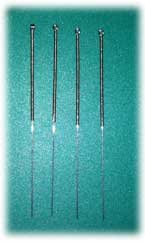Modern research demonstrates that acupuncture reduces hypertension, protects heart tissue and reduces arrhythmias.  Acupuncture for HBPIn one recent study, investigators from the University of California Los Angels and UC Irvine “have shown that electroacupuncture stimulation activates neurons” in specific brain regions thereby reducing hypertension. The investigators mapped the brain network by which acupuncture treatment reduces high blood pressure through the downregulation of excess sympathetic nerve activity. In the study, acupuncture points P5, P6, LI10 and LI11 combined with electroacupuncture stimulation for thirty minutes with 2mA at 2 Hz successfully demonstrated clinical efficacy in the reduction of high blood pressure.
Acupuncture for HBPIn one recent study, investigators from the University of California Los Angels and UC Irvine “have shown that electroacupuncture stimulation activates neurons” in specific brain regions thereby reducing hypertension. The investigators mapped the brain network by which acupuncture treatment reduces high blood pressure through the downregulation of excess sympathetic nerve activity. In the study, acupuncture points P5, P6, LI10 and LI11 combined with electroacupuncture stimulation for thirty minutes with 2mA at 2 Hz successfully demonstrated clinical efficacy in the reduction of high blood pressure.
That’s not all! Other recent research demonstrates that acupuncture has “an antiarrhythmic effect” in the treatment of atrial fibrillation (A-fib). Atrial fibrillation is a common arrhythmia of the heart. In the study, acupuncture points P6 (Neiguan), HT7 (Shenmen) and UB15 (Xinshu) demonstrated clinical efficacy in the reduction of A-fib.
Another recent study from the University of California Los Angeles (UCLA) investigated the effects of electroacupuncture at P5 and P6 and discovered that electroacupuncture protects the heart from tissue death due to obstruction of the blood and oxygen supply. Yes, there’s more modern research! In another study, researchers tested acupuncture point CV17 (Shanzhong) and discovered that acupuncture controls the heart rate and increases the strength of cardiac autonomic function. Needling acupoint CV17 decreased the heart rate and increased the power of the high-frequency component of the HRV (heart rate variability), an index of the body’s ability to maintain control of the heart beat rate and rhythm through vagus nerve activity.
About: HealthCMi authors provide acupuncture CEUs online for acupuncture continuing education and publish up-to-date research through the Healthcare Medicine Institute news service.
References:
Evidence-Based Complementary and Alternative Medicine. Volume 2012 (2012), Article ID 878673, 9 pages. doi:10.1155/2012/878673. Neuroendocrine Mechanisms of Acupuncture in the Treatment of Hypertension. Wei Zhou and John C. Longhurst. Department of Anesthesiology, David Geffen School of Medicine, University of California Los Angeles, Los Angeles, CA. Department of Medicine, University of California Irvine, Irvine, CA.
World J Cardiol. 2012 March 26; 4(3): 60–65. doi: 10.4330/wjc.v4.i3.60. Acupuncture for paroxysmal and persistent atrial fibrillation: An effective non-pharmacological tool? Federico Lombardi, Sebastiano Belletti, Pier Maria Battezzati, and Alberto Lomuscio.
Am J Physiol Heart Circ Physiol. 2012 May;302(9):H1818-25. Epub 2012 Feb 24.
Cardioprotection of electroacupuncture against myocardial ischemia-reperfusion injury by modulation of cardiac norepinephrine release. Zhou W, Ko Y, Benharash P, Yamakawa K, Patel S, Ajijola OA, Mahajan A. Department of Anesthesiology, UCLA - University of California, Los Angeles.
Kurono Y, Minagawa M, Ishigami T, Yamada A, Kakamu T, Hayano J. Auton Neurosci. Acupuncture to Danzhong but not to Zhongting increases the cardiac vagal component of heart rate variability. 2011 Apr 26;161(1-2):116-20. Epub 2011 Jan 7.

